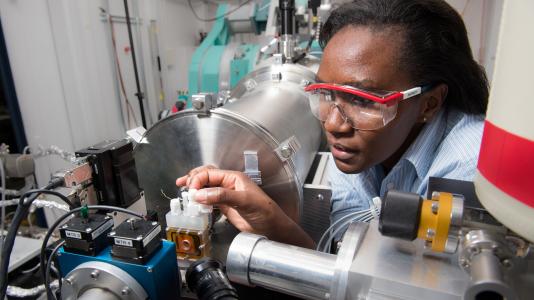- Subnanometer and nanometer catalysts, method for preparing size-selected catalysts (ANL-IN-07-067)
The Pt-cluster based catalysts outperformed the very best reported ODHP catalyst in both activity (by up to two orders of magnitude higher turn-over frequencies) and in selectivity. The results clearly demonstrate that highly dispersed ultra-small Pt clusters precisely localized on high-surface area supports can lead to affordable new catalysts for highly efficient and economic propene production, including considerably simplified separation of the final product. The combined GISAXS-mass spectrometry provides an excellent tool to monitor the evolution of size and shape of nanocatalyst at action under realistic conditions. Also provided are sub-nanometer gold and sub-nanometer to few nm size-selected silver catalysts which possess size dependent tunable catalytic properties in the epoxidation of alkenes.
Invented size-selected cluster deposition provides a unique tool to tune material properties by atom-by-atom fashion, which can be stabilized by protective overcoats.
Subnanometer and nanometer catalysts, method for preparing size-selected catalysts (ANL-IN-07-067)
Presented here is a novel application of size-preselected metal-containing clusters under realistic high temperature catalytic conditions. More specifically, the invention produces and utilizes size selected sub-nanometer metal cluster-based catalysts and up to several nm size-selected nanoparticles for chemical conversions such as epoxidation and dehydrogenation.
Subnanometer and nanometer catalysts, method for preparing size-selected catalysts (ANL-IN-07-067B)
The invention provides a catalytic electrode for converting molecules, the electrode comprising a predetermined number of single catalytic sites supported on a substrate. Also provided is a method for oxidizing water comprising contacting the water with size selected catalyst clusters. The invention also provides a method for reducing an oxidized moiety, the method comprising contacting the moiety with size selected catalyst clusters at a predetermined voltage potential.
